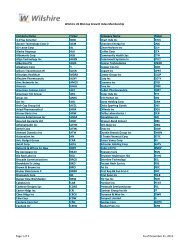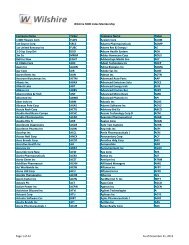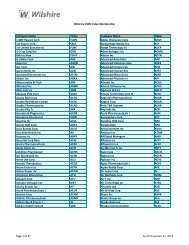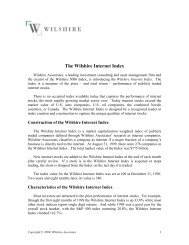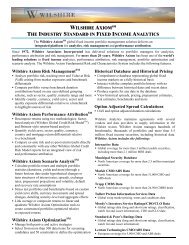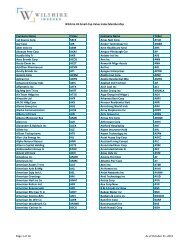Fundamentally Active - Wilshire Associates
Fundamentally Active - Wilshire Associates
Fundamentally Active - Wilshire Associates
Create successful ePaper yourself
Turn your PDF publications into a flip-book with our unique Google optimized e-Paper software.
ubble? It would have been easy to relax the five-year requirement of fundamentals to three years or<br />
even one year in order to allow some of these companies to enter the index. The metrics for combining<br />
fundamentals could have been changed to favor sales. These are examples of “minor” adjustments that<br />
would not compromise the intent of the index but could create differences between live- and back-tested<br />
index returns.<br />
Fundamental indexes are a more reliable, conservative measure of a company’s value<br />
Good or bad, market prices do respond quicker to changes in company valuations than fundamental<br />
measures. This is because prices reflect the expectations of all investors at that moment while<br />
fundamental measures use the past reporting of the company’s financials after their release. Stock<br />
manipulation is difficult and illegal. Fundamental measures are susceptible to both legal and illegal<br />
distortions. For example, a company’s management controls the size and frequency of dividend payments.<br />
These payments affect the company’s weight in many alternatively-weighted indexes. The market<br />
evaluates all news including changes in dividend payouts and adjusts the stock price, if necessary.<br />
A transparent, rules-based index is a passive index<br />
A non-judgmental buy/sell methodology does not make the investment process passive. Passive indexes<br />
theoretically require little to no maintenance—invest in it and forget about it. Low turnover is the appeal<br />
of a passive index and a major selling point for capitalization-weighted investing. In practice, capweighted<br />
indexes require maintenance because of corporate actions and membership changes. 16 If there<br />
were no corporate actions or membership changes, cap-weighted indexes would have zero turnover and<br />
thus zero maintenance. In addition to the turnover created by corporate actions and membership changes,<br />
alternatively weighted indexes have turnover built into the construction methodology. Table 3 identifies<br />
some of the sources of turnover.<br />
Table 3: Potential Sources of Turnover<br />
Sources for Turnover Cap-Weighting S&P Eq Wt RAFI WisdomTree<br />
Membership changes Yes Yes Yes Yes<br />
Dividend payments Yes Yes Yes Yes<br />
Shares outstanding changes (dividend payers) Yes No Yes Yes<br />
Shares outstanding changes (non-dividend payers) Yes No No No<br />
Price changes No Yes No No<br />
Sales changes No No Yes No<br />
Cash flow changes No No Yes No<br />
Book value changes No No Yes No<br />
It is important to point out that cap-weighting an index does not make it passive. Cap-weighted style<br />
benchmark indexes have imbedded, active style bets similar to fundamental indexes. The difference is<br />
that cap-weighted style benchmarks attempt to reflect the sum of all investors of the targeted style or the<br />
style’s beta. Turnover is a result of making the style index more representative of the targeted style.<br />
Fundamental index goals, like those of any active manager, are to outperform. Research Affiliates’ Jason<br />
Hsu, when asked to clarify if the RAFI was active or passive during a May 1, 2007 roundtable sponsored<br />
by Global Pensions, replied: “I’m leaning towards active, low turnover, rules-based.” 17<br />
16 Membership changes include mergers and acquisitions, IPOs, delistings, as well as size, style, industry and<br />
country changes for sub-indexes.<br />
17 “The age of investment strategy indices,” Global Pensions, June 2007: page 40.<br />
<strong>Fundamentally</strong> <strong>Active</strong><br />
Copyright © 2007, <strong>Wilshire</strong> <strong>Associates</strong> Incorporated. All rights reserved.<br />
Page 5



